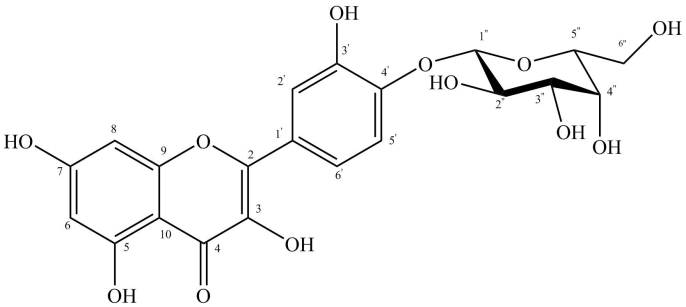ОСОБЕННОСТИ СОСТАВА ФЛАВОНОИДОВ В СЕРПУХЕ ВЕНЦЕНОСНОЙ (SERRATULA CORONATA L.S.L.) СИБИРИ И ДАЛЬНЕГО ВОСТОКА РОССИИ
УДК 615.322:581.19
Аннотация
Одним из распространенных в Сибири и Дальнем Востоке России, но малоизученных растений является серпуха венценосная (Serratula coronata L.s.l.) семейства астровые (Asteraceae). Ценность этого растения обусловливается высоким содержанием в нем фитоэкдистероидов и флавоноидов. Из надземной части (листьев, стеблей) S. coronata L.s.l., произрастающей в Сибири (Алтайский край), методами жидкостной экстракции (70%-ным этиловым спиртом) и препаративной колоночной хроматографии на силикагеле в режиме градиентного элюирования смесью растворителей (четыреххлористого углерода и этилового спирта), выделено 2 флавоноида: кверцетин-4'-O-β-D-глюкопиранозид, лютеолин-4'-O-β-D-глюкопиранозид. Идентификацию выделенных соединений проводили методами УФ-, ЯМР-13С-, 1H,13C-HMBC-спектроскопии и масс-спектрометрии с ионизацией электрораспылением. Методом обращенно-фазовой высокоэффективной жидкостной хроматографии (ОФ ВЭЖХ) впервые исследован качественный состав и количественное содержание отдельных флавоноидов в растениях S. coronata L.s.l., произрастающих на территории Алтая и в Приморском крае Российской Федерации. Состав флавоноидных гликозидов и распределение их агликонов в сибирских и дальневосточных растениях отличаются, и это можно считать хемотаксономическим признаком вида S. coronata L.s.l. Методом спектрофотометрии определена сумма флавоноидов в надземных органах серпухи венценосной, произрастающих в Алтайском и Приморском краях. Содержание флавоноидов в листьях растения (6.7–8.3%) превышает их содержание в стеблях (0.5–0.9%). Серпуха венценосная является потенциальным источником биологически активных соединений этого класса.
Скачивания
Metrics
Литература
Vorob'yeva A.N., Zarembo Ye.V., Rybin V.G. Byulleten' fiziologii i patologii dykhaniya, 2006, no. 22, pp. 90–93. (in Russ.).
Zarembo Ye.V., Gorovoy P.G., Sokolova L.I. Rastitel'nyye resursy, 2001, vol. 37, no. 3, pp. 59–64. (in Russ.).
Volodin V.V., Pchelenko L.D., Volodina S.O., Kudryasheva A.G., Shevchenko O.G., Zagorskaya N.V. Rastitel'nyye resursy, 2006, vol. 42, no. 3, pp. 113–130. (in Russ.).
Punegova N.V. Farmakologicheskiye svoystva ekdisteroidsoderzhashchey substantsii "Ekdisteron-80", poluchennoy iz serpukhi ventsenosnoy (Serratula coronata L.): eksperimental'noye issledovaniye: avtoref. dis. ... kand. farm. nauk. [Pharmacological properties of ecdysteroid-containing substance "Ecdysterone-80", obtained from Crowned Serpenta (Serratula coronata L.): experimental study: author. dis. ... cand. farm. sciences]. Pyatigorsk, 2009, 23 p. (in Russ.).
Vysochina G.I., Shinkarenko Yu.V., Kukushkina T.A., Bayandina I.I. Chemistry for Sustainable Development, 2008, vol. 16, pp. 375–381.
Myagchilov A.V. Flavonoidy rasteniy Fagopyrum sagittatum Gilib. (grechikhi posevnoy) i Serratula coronata L. (ser-pukhi ventsenosnoy) (metody vydeleniya, identifikatsiya veshchestv, perspektivy ispol'zovaniya): avtoref. dis. … kand. biol. nauk. [Flavonoids of plants Fagopyrum sagittatum Gilib. (seeded buckwheat) and Serratula coronata L. (crowned sickles) (isolation methods, identification of substances, prospects for use): author. dis. ... cand. biol. sciences]. Vladi-vostok, 2015, 21 p. (in Russ.).
Angaskiyeva A.S. Farmakognosticheskoye issledovaniye serpukhi ventsenosnoy, kul'tiviruyemoy v Sibiri: avtoref. dis. ... kand. farm. nauk. [Pharmacognostic study of crowned sickles cultivated in Siberia: author. dis. ... cand. farm. scienc-es]. Tomsk, 2006, 19 p. (in Russ.).
Myagchilov A.V., Goncharenko O.E., Sokolova L.I., Gorovoy P.G., Dmitrenok P.C. Izvestiya VUZov. Prikladnaya khimiya i biotekhnologiya, 2011, no. 1, pp. 53–56. (in Russ.).
Bathori M., Zupko I., Hunyadi A., Gacsne-Baiz E., Dinya Z., Forgo P. Fitoterapia, 2004, vol. 75, no. 2, pp. 162–167. DOI: 10.1016/j.fitote.2003.12.009.
Dorkina Ye.G. Gepatoprotektornyye svoystva flavonoidov: farmakodinamika i perspektivy klinicheskogo izucheniya: avtoref. dis. ... doktora biol. nauk. [Hepatoprotective properties of flavonoids: pharmacodynamics and prospects for clinical study: author. dis. ... doctor biol. sciences]. Volgograd, 2010, 48 p. (in Russ.).
Rogovskiy V.S., Matyushin A.I., Shimanovskiy N.L. Mezhdunarodnyy meditsinskiy zhurnal. 2011, no. 3, pp. 114–118. (in Russ.).
Tarakhovskiy Yu.C., Kim Yu.A., Abdrasilov B.C., Muzafarov Ye.N. Flavonoidy: biokhimiya, biofizika, meditsina. [Flavonoids: biochemistry, biophysics, medicine]. Pushchino, 2013, 310 p. (in Russ.).
Wang Y., Hamburger M., Gueho J., Hostetmann K. Phytochemistry, 1989, vol. 28, no. 9, pp. 2323–2327. DOI: 10.1016/s0031-9422(00)97976-7.
Kitagawa M. Botanical Magazine, 1935, vol. 49, p. 229.
Voroshilov V.N. Floristicheskiye issledovaniya v raznykh rayonakh SSSR. [Floristic studies in different regions of the USSR]. Moscow, 1985, 210 p. (in Russ.).
Kitagawa M. Neo-Lineamentra Florae Manshuricae. Vaduz: J. Cramer, 1979, 715 p.
Barkalov V.Yu. Sosudistyye rasteniya sovetskogo Dal'nego Vostoka. [Vascular plants of the Soviet Far East]. St. Pe-tersburg, 1992, vol. 6, pp. 309–312. (in Russ.).
Wawer I., Zielinska A. Magnetic resonance chemistry, 2001, no. 39, pp. 374–380. DOI: 10.1002/mrc.871.
Andersen Q.M. Flavonoids: Сhemistry, Biochemistry and Applications. Boca Raton, 2006, 1197 p. DOI: 10.1002/ange. 200685399.
Agrawal P.K. Phytochemistry, 1992, vol. 31, no. 10, pp. 3307–3330. DOI: 10.1016/0031-9422(92)83678-r.
Myagchilov A.V., Sokolova L.I., Gorovoy P.G. Nauchno-tekhnicheskiy potentsial kak osnova sotsial'no-ekonomicheskogo razvitiya. [Scientific and technical potential as the basis of socio-economic development]. M., 2018, pp. 365–368. (in Russ.).
Day A.J., Bao Y., Morgan MR.A., Williamson G. Free Radical Biology & Medicine, 2000, vol. 29, no. 12, pp. 1234–1243. DOI: 10.1016/s0891-5849(00)00416-0.
Andreyeva V.Yu., Kalinkina G.I. Khimiya Rastitel'nogo Syr'ya, 2000, no. 1, pp. 85–88. (in Russ.).
Lomboyeva S.S., Tankhayeva L.M., Olennikov D.N. Khimiya Rastitel'nogo Syr'ya, 2008, no. 2, pp. 65–68. (in Russ.).

Copyright (c) 2020 Химия растительного сырья

Это произведение доступно по лицензии Creative Commons «Attribution» («Атрибуция») 4.0 Всемирная.

This work is licensed under a Creative Commons Attribution 4.0 International License.
Авторы, которые публикуются в данном журнале, соглашаются со следующими условиями:
1. Авторы сохраняют за собой авторские права на работу и передают журналу право первой публикации вместе с работой, одновременно лицензируя ее на условиях Creative Commons Attribution License, которая позволяет другим распространять данную работу с обязательным указанием авторства данной работы и ссылкой на оригинальную публикацию в этом журнале.
2. Авторы сохраняют право заключать отдельные, дополнительные контрактные соглашения на неэксклюзивное распространение версии работы, опубликованной этим журналом (например, разместить ее в университетском хранилище или опубликовать ее в книге), со ссылкой на оригинальную публикацию в этом журнале.
3. Авторам разрешается размещать их работу в сети Интернет (например, в университетском хранилище или на их персональном веб-сайте) до и во время процесса рассмотрения ее данным журналом, так как это может привести к продуктивному обсуждению, а также к большему количеству ссылок на данную опубликованную работу.











